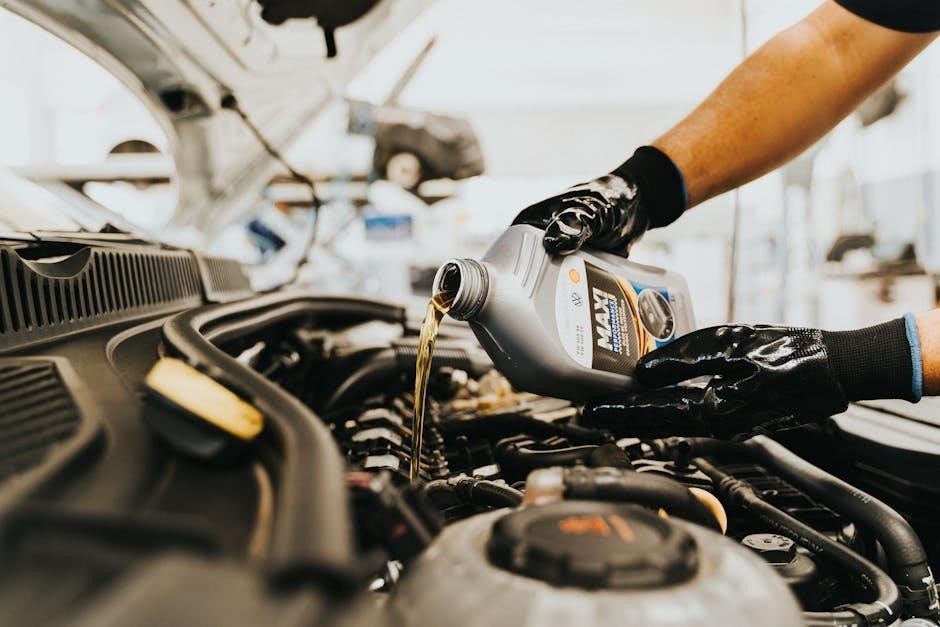Changing manual gearbox oil is crucial for smooth operation and protecting internal components. It’s a straightforward process that helps maintain performance and longevity. Always use the correct oil type to avoid damage. This guide will walk you through the steps to do it effectively.

When to Change Manual Gearbox Oil
Change manual gearbox oil every 30,000 to 50,000 miles or as specified in your vehicle’s service manual. Regular changes prevent wear and ensure smooth operation.
Frequency of Oil Change
The frequency of changing manual gearbox oil varies depending on the vehicle and driving conditions. Typically, it is recommended every 30,000 to 50,000 miles. Some manufacturers suggest intervals up to 60,000 miles, while others advise shorter periods for high-stress driving. Always consult your vehicle’s service manual for specific guidelines. Regular oil changes help maintain smooth gear shifts and prevent premature wear of internal components. Overlooking this maintenance can lead to costly repairs down the road. Consistency is key to ensuring optimal performance and longevity of your manual gearbox.
Signs That Indicate an Oil Change is Needed
Certain signs indicate that your manual gearbox oil needs changing. Difficulty shifting gears, grinding noises, or a sluggish response are common indicators. If the oil is dirty or dark, it’s time for a change. A burning smell or visible metal shavings in the oil also signal urgency. Ignoring these signs can lead to costly damage, such as worn synchronizers or gear teeth. Regular inspection and timely oil changes ensure smooth operation and extend the gearbox’s lifespan; Always address these signs promptly to maintain optimal performance and avoid mechanical failure.

Choosing the Right Gearbox Oil
Selecting the correct gearbox oil ensures optimal performance and prevents damage. Always use oil certified for your gearbox type, such as GL-4 or specific manufacturer recommendations, to avoid issues.
Understanding Gearbox Oil Specifications
Gearbox oil specifications are critical to ensure proper lubrication and protection; Look for oils meeting API GL-4 or GL-5 standards, designed for manual transmissions. Viscosity levels must match your vehicle’s needs, typically ranging from 75W-90 to 80W-140. Synthetic oils offer better performance in extreme temperatures. Always check your vehicle’s manual for recommended specifications, as some gearboxes require specific formulations. Using the wrong oil can lead to premature wear or failure. Ensure the oil is certified for your gearbox type to maintain optimal performance and longevity. Proper oil selection is key to a successful gearbox oil change.
Recommended Oil Types for Different Gearboxes
Choosing the right oil for your manual gearbox depends on its type and usage. For most standard transmissions, a high-quality 75W-90 synthetic gear oil is ideal. Racing or high-performance gearboxes may require heavier oils like 80W-140. Some vehicles, like older models or specific brands, might need specialized oils, such as Castrol BOT 352 B1 for certain Volvo transmissions. Always refer to your vehicle’s manual to confirm the recommended oil type. Using the correct oil ensures proper lubrication, reduces wear, and prevents damage. Generic or incorrect oils can lead to gearbox failure, so it’s essential to select the right one for your specific needs.
Tools and Materials Required
A socket set, drain pan, syringe, and new gearbox oil are essential. Ensure you have the correct oil type and tools before starting the process for safety and efficiency.
Essential Tools for the Job
To change your manual gearbox oil, you’ll need a socket set, drain pan, syringe, and new gearbox oil. A car jack or axle stands are necessary for lifting the vehicle safely. Ensure you have gloves, goggles, and rags for protection and cleanup. Some gearboxes may require specific tools, like a fill plug wrench or level plug remover. Always refer to your car’s manual for precise tool requirements. Having the right equipment on hand ensures the process is efficient and safe. Avoid using makeshift tools, as they can damage the gearbox or lead to spills. Proper preparation prevents delays and potential hazards during the oil change process.
Materials Needed
The essential materials for a manual gearbox oil change include high-quality gearbox oil meeting your car’s specifications, a drain pan, and new oil filters if required. You’ll also need rags for cleaning spills and a syringe or pump for refilling, as some gearboxes have inaccessible fill holes. Ensure you have the correct type of oil, such as GL-4 or synthetic gear oil, as specified in your vehicle’s manual. Some gearboxes may require sealant for the drain plug. Always check your manual for the exact oil capacity and type to avoid using incorrect materials that could damage the gearbox. Proper materials ensure a smooth and safe process.

Preparing the Car
Warm up the engine by driving briefly to ensure the oil drains easily. Raise the car on axle stands for safe access to the gearbox. Ensure vehicle stability for a secure workspace.
Warming Up the Engine
Before starting, drive the car for a few minutes to warm the engine. This ensures the gearbox oil reaches optimal temperature for proper drainage. Avoid overheating the engine, as it can cause damage. A warm engine helps the oil flow smoothly, making the draining process more efficient and effective. Ensure the car is on level ground to maintain consistent oil flow. This step is essential for a successful oil change and prevents any complications during the process. Always follow safety guidelines when working with hot engines and sharp tools.
Raising the Car and Ensuring Safety
Raising the car securely is essential for safe access to the gearbox. Use sturdy axle stands and ensure the vehicle is on level ground. Engage the handbrake and place blocks behind the rear wheels for added stability. Never rely solely on a jack to support the car while working underneath it. Wear protective gloves and eyewear to prevent injury. Ensure the area is well-ventilated and free from hazards. Double-check that all supports are in place before starting work. Safety should always be the top priority when performing maintenance. Follow the manufacturer’s guidelines for proper lifting techniques to avoid accidents.
Draining the Old Oil
Locate the drain plug at the bottom of the gearbox and position a pan to catch the old oil. Remove the plug carefully, allowing the oil to flow out completely. Be prepared for the initial rush and ensure the pan is large enough to hold the fluid. Once the flow slows, replace the drain plug securely to avoid leaks. This step is crucial for maintaining cleanliness and ensuring the new oil performs effectively. Always dispose of the used oil responsibly.
Locating the Drain Plug
To locate the drain plug, refer to your vehicle’s service manual, as its position varies by model. It’s often found at the bottom or underside of the gearbox. Ensure the car is on level ground or raised securely. Use a flashlight to identify the plug, typically near the front or rear of the gearbox. Before starting, double-check the manual to confirm the location and type of plug. This step is crucial to avoid damaging the gearbox or spilling oil unnecessarily. Always ensure safety and consult the manual if unsure.
Draining the Oil Safely
Draining the oil safely requires careful preparation. Position a drain pan under the gearbox to catch the oil. Use a socket wrench to remove the drain plug slowly, allowing the oil to flow into the pan. Be cautious, as the oil may still be hot. Wear protective gloves and eyewear to avoid splashes. Once the flow slows, replace the drain plug securely. Inspect the old oil’s color and consistency to assess the gearbox’s condition. Properly dispose of the used oil and filter at a recycling center to protect the environment. Safety and cleanliness are key during this process.
Refilling with New Oil
Refill the gearbox with the correct oil type, using a syringe or pump. Ensure the car is level and fill until the oil begins to spill slightly. Consult the manual for the exact oil capacity to avoid overfilling. Proper refilling ensures smooth gearbox operation and prevents damage. Always double-check the oil level before finishing.
How Much Oil to Use
The amount of oil needed varies by gearbox model, typically ranging from 1 to 4 liters. Always consult the vehicle’s manual for exact specifications. Use a syringe or pump to refill, ensuring the car is level. Fill until oil starts to seep from the level plug. Overfilling can damage seals, so be precise. For most manual gearboxes, 2-3 liters are common. Double-check the oil level after refilling. Clean the area around the fill plug to prevent contamination. Proper oil quantity ensures smooth operation and protects internal components. Avoid guesses—stick to the recommended volume for optimal performance.
Refilling the Gearbox
Use a syringe or pump to refill the gearbox with the recommended oil type. Ensure the car is level to avoid air bubbles. Insert the oil into the fill hole until it begins to seep from the level plug. Clean the area around the plug to prevent contamination. Replace the plug and check for leaks. It’s essential to use the correct oil specification to maintain gearbox health. Double-check the oil level after refilling to ensure accuracy. Proper refilling ensures smooth operation and longevity of the transmission components. Always refer to the vehicle’s manual for specific instructions.

Safety Precautions
- Always wear gloves and goggles to protect against spills and debris.
- Ensure the car is on level ground and securely supported by jack stands.
- Dispose of used oil and filters responsibly to protect the environment.
- Work in a well-ventilated area to avoid inhaling harmful fumes.
Important Safety Measures
When changing manual gearbox oil, prioritize safety to avoid accidents and ensure the job is done correctly. Always wear protective gloves and goggles to shield yourself from potential oil spills and debris. Ensure the car is securely lifted using jack stands on a level surface to prevent it from falling. Never work under an unsupported vehicle. Properly ventilate the workspace to avoid inhaling harmful fumes from the gearbox oil. After draining the old oil, handle it carefully and store it in sealed containers for responsible disposal. Check for any leaks after refilling and tighten all plugs securely. Safety measures protect both you and your car.
Disposal of Used Oil
Proper disposal of used gearbox oil is essential to protect the environment. Never pour used oil down drains or mix it with household waste, as it can contaminate water and soil. Instead, collect the oil in a leak-proof container with a tight-fitting lid. Many auto repair shops, service stations, or recycling centers accept used oil for proper disposal. Check local regulations for designated drop-off locations. Ensure the container is labeled as “used motor oil” to avoid confusion. Responsible disposal helps prevent environmental harm and adheres to local laws. Always handle used oil carefully to minimize its impact on the ecosystem.
Common Mistakes to Avoid
Using the wrong oil type can damage the gearbox. Overfilling or underfilling leads to poor performance. Always follow the manual’s recommendations to ensure proper oil levels and type.
Using the Wrong Oil Type
Using the incorrect oil type is a common mistake that can severely damage your gearbox. Always consult your vehicle’s service manual to ensure compatibility. GL-4 or GL-5 certified oils are typically recommended for manual gearboxes, depending on the manufacturer; Using automatic transmission fluid (ATF) or engine oil can lead to premature wear, overheating, or gear failure. Volvo and Renault models often require specific oils, such as Castrol BOT 352 B1 or GL-4 certified options. Avoid generic or universal oils unless explicitly approved by your gearbox manufacturer. The wrong oil can void warranties and cause irreversible damage, so double-check specifications before refilling.
Overfilling or Underfilling the Gearbox
Overfilling or underfilling the gearbox can lead to serious issues. Excess oil may leak onto components or cause pressure buildup, damaging seals and gears. Conversely, insufficient oil results in inadequate lubrication, leading to wear and overheating. Always refer to your vehicle’s manual for the correct oil level. Use a syringe or funnel to fill carefully, especially if the fill hole is hard to reach. Monitor the oil level closely during refilling to avoid these common mistakes. Proper filling ensures optimal gearbox performance and prevents costly repairs down the line.
Regular manual gearbox oil changes are essential for maintaining smooth operation and protecting internal components. By following the steps outlined, you can ensure your gearbox runs efficiently and lasts longer. Always use the correct oil type and avoid common mistakes like overfilling or underfilling. Consulting your vehicle’s service manual is key for specific recommendations. Remember, proper maintenance prevents costly repairs and keeps your car performing at its best.